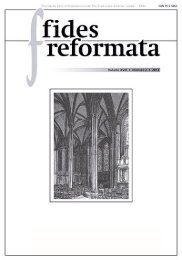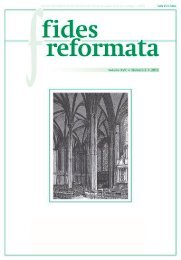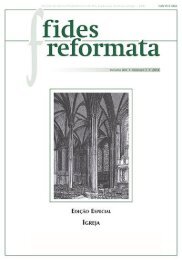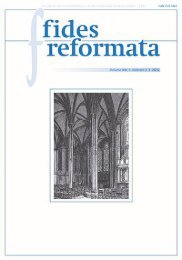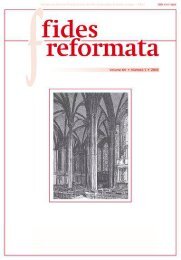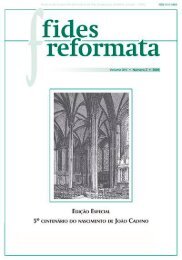You also want an ePaper? Increase the reach of your titles
YUMPU automatically turns print PDFs into web optimized ePapers that Google loves.
FIDES REFORMATA XIX, Nº 2 (2014): 95-115<br />
of Jesus to his beloved disciple in direct speech, a question that would remain<br />
up in the air: “If it is my will that he [Peter] remain until I come, what is that<br />
to you?” In the third place, in John’s Gospel we find a parallel in which the<br />
author corrects a wrong interpretation of an utterance from Jesus, namely<br />
2:21: “But he was speaking about the temple of his body.” This shows that the<br />
verses 24-25 <strong>do</strong> not need to be taken as an editorial addition; rather, they form<br />
an integral part of chapter 21, whatever one may think about the authenticity<br />
of this chapter. 28<br />
Option 2 can be traced back to Augustine; more recent proponents of it are<br />
Hartwig Thyen and Richard Bauckham. In their view, 20:30-31 and 21:24-25<br />
form a carefully arranged inclusion within chapter 21. Thyen considers chapter<br />
1-20 to be a testimony to Jesus through this Gospel and regards chapter 21 as<br />
a testimony of Jesus to this Gospel. 29 According to Bauckham the prologue<br />
outlines the pre-history of the gospel as the epilogue <strong>do</strong>es the post-history. 30<br />
Many conservative exegetes share that view. However, they <strong>do</strong>wnplay a textual<br />
problem. How is it possible that the author of the Fourth Gospel refers to<br />
himself in three different ways, even in one sentence, and continues in the next<br />
one with the first person singular? The “we”-form evokes questions particularly<br />
in verse 24b. In Part 1 above we already saw how Bauckham tries to avoid this<br />
textual problem by interpreting this first person plural as a plural of authority.<br />
Option 1 is favoured by most exegetes today. However, they also <strong>do</strong>wnplay<br />
the above mentioned problem. They state that from the verses 23/24<br />
onward the publishers are speaking and are responsible for this chapter as<br />
a whole. They first identify the beloved disciple as the author, then they say<br />
as a certificate of authenticity, which would have been added by an editor, Baum argues that this would<br />
only be true for poetic literature, and only as self-identification by the author [155-156]. CULPEPPER,<br />
R. Alan. John 21:24-25: The Johannine Sphragis. In: ANDERSON, Paul N. e.a. (eds.). John, Jesus, and<br />
History, Volume 2. Aspects of Historicity in the Fourth Gospel. Atlanta: Society of Biblical Literature,<br />
2009, p. 349-364.<br />
28 On careful consideration of all the arguments, Porter comes to the conclusion that there are no<br />
compelling reasons whatsoever against the authenticity of chapter 21. Taking the tradition of the manuscripts<br />
into consideration, the Fourth Gospel has never been in circulation without chapter 21. PORTER, Stanley<br />
E. The Ending of John’s Gospel. In: BRACKNEY, William H. & EVANS, Craig A. (eds.). From Biblical<br />
Criticism to Biblical Faith. FS Lee M. Mc.Donald. Macon: Mercer, 2007, p. 55-73; see also MINEAR,<br />
Paul S. The Original Functions of John 21. Journal of Biblical Literature 102 (<strong>19</strong>83), p. 85-98; BERGER,<br />
Klaus. Kommentar zum Neuen Testament. Gütersloh: Gütersloher Verlagshaus, 2011, p. 412-413: he says<br />
among other things that a redactor could have easily removed the disagreeable “first ending” (20:30-31).<br />
The reference to “sons of Zebedee” (21:2) has a connection point only outside the Fourth Gospel (Baum,<br />
Observations, p. 136: the names of both sons are not mentioned, nor the names of their parents), yet the<br />
same is true for other references to the synoptic tradition, such as 11:2 (it <strong>do</strong>es not point ahead to 12:1-8<br />
but it refers to that what generally was known). This reference is made in the context of going fishing on<br />
the lake of Galilee.<br />
29 THYEN, Das Johannesevangelium, p. 772-774.<br />
30 BAUCKHAM, Jesus and the Eyewitnesses, p. 364-369.<br />
105






